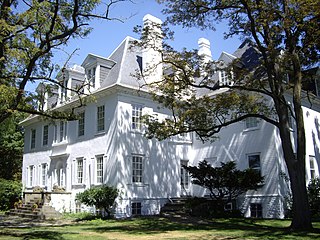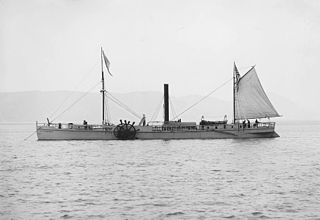
Robert Fulton was an American engineer and inventor who is widely credited with developing a commercially successful steamboat; the first was called The North River Steamboat. In 1807 that steamboat traveled on the Hudson River with passengers, from New York City to Albany and back again, a round trip of 300 miles, in 62 hours. The success of his steamboat changed river traffic and trade on major American rivers.

A steamboat is a boat that is propelled primarily by steam power, typically driving propellers or paddlewheels. Steamboats sometimes use the prefix designation SS, S.S. or S/S or PS, however these designations are most often used for steamships.

SS Princess Alice, formerly PS Bute, was a passenger paddle steamer that sank on 3 September 1878 after a collision with the collier Bywell Castle on the River Thames. Between 600 and 700 people died, all from Princess Alice, the greatest loss of life of any British inland waterway shipping accident. No passenger list or headcount was made, so the exact figure of those who died has never been known.

A paddle steamer is a steamship or riverboat powered by a steam engine that drives paddle wheels to propel the craft through the water. In antiquity, paddle wheelers followed the development of poles, oars and sails, where the first uses were wheelers driven by animals or humans.

Events from the year 1809 in Canada.

Richard Henry Blood Sr., better known by his ring name Ricky "The Dragon" Steamboat, is an American retired professional wrestler. He is best known for his work with the American Wrestling Association (AWA), Jim Crockett Promotions (JCP), World Championship Wrestling (WCW), and the World Wrestling Federation (WWF).

PS Kingswear Castle is a steamship. She is a coal-fired river paddle steamer, dating from 1924 with engines from 1904. After running summer excursions on the River Medway and the Thames for many years she returned to the River Dart in Devon in December 2012 to run excursions from 2013 onwards on the river she was built on and for. Kingswear Castle is listed as part of the National Historic Fleet of ships of "Pre-eminent National Significance".

The Clermont State Historic Site, also known as the Clermont estate, the Clermont Manor or just Clermont, is a New York State Historic Site in southwestern Columbia County, New York, United States. It protects
the former estate of the Livingston family, seven generations of whom lived on the site over more than two centuries.
The Woolwich Steam Packet Company, operated between 1834 and 1888 and offered steamer services from central London to Woolwich and later to Kent, Essex and Suffolk. One of its ships, the Princess Alice sank after a collision near Woolwich with the loss of almost 700 lives in the greatest disaster in the history of British coastal cruising.

The North River Steamboat or North River, colloquially known as the Clermont, is widely regarded as the world's first vessel to demonstrate the viability of using steam propulsion for commercial water transportation. Built in 1807, the North River Steamboat operated on the Hudson River – at that time often known as the North River – between New York City and Albany, New York. She was built by the wealthy investor and politician Robert Livingston and inventor and entrepreneur Robert Fulton (1765–1815).

Little Old New York is a 1940 American black-and-white historical drama from 20th Century Fox, produced by Darryl F. Zanuck, directed by Henry King, that stars Alice Faye, Fred MacMurray, and Richard Greene. The film is based on a play by Rida Johnson Young, which opened on Broadway on September 8, 1920, and starred Genevieve Tobin, Douglas Wood, and Donald Meek.

Steamboats in Canada have a long history, both freshwater and oceangoing.

Thealka is an unincorporated community in Johnson County, Kentucky, United States. It was created by the North East Coal Company in 1906 and was originally called Muddy Branch. In 1911, it was renamed "Thealka" after the steamboat known by the same name. Both the community and the steamboat were named after John C.C. Mayo's wife, Alice Jane Mayo, who was given the nickname "Alka". Thealka is in the 41240 ZIP Code Tabulation Area, which includes the nearby city of Paintsville.
The Belfast Steamship Company provided shipping services between Belfast in Ireland and Liverpool in England from 1852 to 1975.
PS Stanley was a paddle steamer passenger vessel operated by the London and North Western Railway from 1864 to 1888.

Alice Gertrude was a wooden steamship which operated on the Strait of Juan de Fuca and Puget Sound from 1898 to January 1907, when she was wrecked at Clallam Bay in Washington.

Alice was a stern-wheel driven steamboat that operated on the Willamette and Columbia rivers in the 1870s and 1880s. Alice was the largest vessel built above Willamette Falls and was considered in its day to be the "Queen of the River". This steamer was rebuilt after near-destruction in a fire at Oregon City, Oregon in May 1873. In 1876, it was withdrawn from the upper Willamette River and transferred to the Columbia River, where it was worked as a towboat moving ocean-going ships to and from Portland and Astoria, Oregon, near the mouth of the Columbia River.














